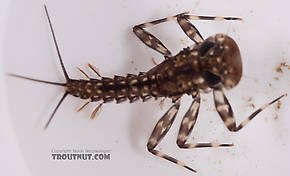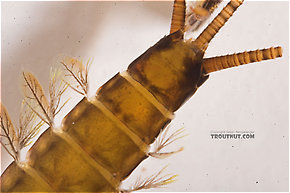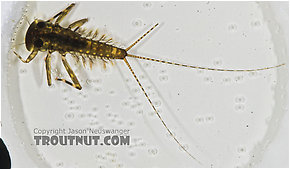Blog & Latest Updates
Fly Fishing Articles
Insects by Common Name


Mayfly Genus Heptagenia
Taxonomic Navigation -?-
Kingdom
Animalia (Animals)
» Phylum
Arthropoda (Arthropods)
» Class
Insecta (Insects)
» Order
Ephemeroptera (Mayflies)
» Genus Heptagenia
| Species in Heptagenia | ||
| Heptagenia adaequata | 0 | 0 |
| Heptagenia culacantha | 0 | 0 |
| Heptagenia diabasia | 0 | 0 |
| Heptagenia elegantulaPale Evening Dun | 0 | 0 |
| Heptagenia pullaGolden Dun | 0 | 0 |
| Heptagenia solitariaGinger Quill | 0 | 0 |
6 species aren't included.
Of the remaining species, the best hatches come from Heptagenia elegantula in the West. The genus is generally unimportant in the East and Midwest, where the most likely species to produce fishable hatches is Heptagenia pulla.
Hatching Behavior
Heptagenia nymphs emerge very quickly, so emerger patterns are unimportant. The duns may or may not float long enough to get trout excited.
Spinner Behavior
Spinner falls give the most promising action produced by Heptagenia species.
Pictures of 11 Mayfly Specimens in the Genus Heptagenia:
Heptagenia pulla (Golden Dun) Mayfly Nymph View 8 PicturesLike most Alaskan mayflies, this one is tricky to identify to the species level. See the discussion section for an informative chat about this one's ID. The current leaning is to call it a fairly immature Heptagenia pulla nymph, but a case has been made for Heptagenia elegantula as well.
View 8 PicturesLike most Alaskan mayflies, this one is tricky to identify to the species level. See the discussion section for an informative chat about this one's ID. The current leaning is to call it a fairly immature Heptagenia pulla nymph, but a case has been made for Heptagenia elegantula as well.
 View 8 PicturesLike most Alaskan mayflies, this one is tricky to identify to the species level. See the discussion section for an informative chat about this one's ID. The current leaning is to call it a fairly immature Heptagenia pulla nymph, but a case has been made for Heptagenia elegantula as well.
View 8 PicturesLike most Alaskan mayflies, this one is tricky to identify to the species level. See the discussion section for an informative chat about this one's ID. The current leaning is to call it a fairly immature Heptagenia pulla nymph, but a case has been made for Heptagenia elegantula as well.Heptagenia elegantula (Pale Evening Dun) Mayfly Nymph View 6 Pictures
View 6 Pictures
 View 6 Pictures
View 6 PicturesCollected June 5, 2005 from Eighteenmile Creek in Wisconsin
Added to Troutnut.com by Troutnut on May 24, 2006
Added to Troutnut.com by Troutnut on May 24, 2006
Heptagenia pulla (Golden Dun) Mayfly Nymph View 5 PicturesI used a microscope to positively identify this nymph as Heptagenia pulla. (Edit six years later: I wish I had explained why I was positive about this. It may have been based on color patterns in an angling text, which are not especially reliable for species ID anymore.)
View 5 PicturesI used a microscope to positively identify this nymph as Heptagenia pulla. (Edit six years later: I wish I had explained why I was positive about this. It may have been based on color patterns in an angling text, which are not especially reliable for species ID anymore.)
 View 5 PicturesI used a microscope to positively identify this nymph as Heptagenia pulla. (Edit six years later: I wish I had explained why I was positive about this. It may have been based on color patterns in an angling text, which are not especially reliable for species ID anymore.)
View 5 PicturesI used a microscope to positively identify this nymph as Heptagenia pulla. (Edit six years later: I wish I had explained why I was positive about this. It may have been based on color patterns in an angling text, which are not especially reliable for species ID anymore.)Collected June 5, 2005 from the Long Lake Branch of the White River in Wisconsin
Added to Troutnut.com by Troutnut on May 25, 2006
Added to Troutnut.com by Troutnut on May 25, 2006
Recent Discussions of Heptagenia
Added more Heptagenia culacantha info 12 Replies »
Posted by Troutnut on Dec 19, 2006 in the species Heptagenia culacantha
Last reply on Feb 8, 2012 by Entoman
I went to the entomology library today and photocopied the 1985 paper that first described this curious species. I've updated the culacantha page with this information.
ReplyLink to pictures of H. culacantha 2 Replies »Posted by Troutnut on Oct 20, 2006 in the species Heptagenia culacantha
Last reply on Oct 4, 2007 by Troutnut
Many thanks to user Softhackle for digging up this link. I knew about the thread from back when it started, but I wasn't able to find it when I went back to look last night. Good work!
Fly Fisherman Magazine forum topic with two pictures of a H. culacantha dun.
I've added the species to the "live" part of the database and put up a rudimentary page where I can compile any more information we find.
ReplyDoes anyone know anything about Heptagenia culacantha? 8 Replies »Fly Fisherman Magazine forum topic with two pictures of a H. culacantha dun.
I've added the species to the "live" part of the database and put up a rudimentary page where I can compile any more information we find.
Posted by GONZO on Oct 19, 2006 in the species Heptagenia culacantha
Last reply on Apr 18, 2007 by Konchu
This is a shot in the dark, but I'm trying to track down descriptive information about a rather rare "mystery mayfly." Heptagenia culacantha was identified in 1985 (Evans, Botts, & Flowers). About all I have right now is a tease from the Journal of the New York Entomological Society--"This infrequently taken species, one of the largest and most striking North American heptageniids, is known only from Pennsylvania and New York."
The reason I'm so interested is that I believe I encounter a fishable hatch of these mayflies every season on one of my favorite PA brook trout headwaters. If that conjures a picture of fishing to 6-7" dinks, you'll need to double those numbers to appreciate how special this stream really is. Add to that an image of the fish rising to these beautiful "mystery mayflies" that hatch in the evening, following a day-long emergence of Dark Green Drakes (Litobrancha recurvata)!
It is such a special event that it is one of the very few things that can pull me away from fishing my favorite Olive Morning Dun hatch (Drunella lata, nee cornuta). Help!
ReplyThe reason I'm so interested is that I believe I encounter a fishable hatch of these mayflies every season on one of my favorite PA brook trout headwaters. If that conjures a picture of fishing to 6-7" dinks, you'll need to double those numbers to appreciate how special this stream really is. Add to that an image of the fish rising to these beautiful "mystery mayflies" that hatch in the evening, following a day-long emergence of Dark Green Drakes (Litobrancha recurvata)!
It is such a special event that it is one of the very few things that can pull me away from fishing my favorite Olive Morning Dun hatch (Drunella lata, nee cornuta). Help!
There are 5 more topics.
Your Thoughts On Heptagenia:
Top 10 Fly Hatches
Top Gift Shop Designs
Eat mayflies.
Top Insect Specimens
Miscellaneous Sites
Troutnut.com is copyright © 2004-2024 Jason
Neuswanger (email Jason). See my FAQ for information about use of my images.
 privacy policy
privacy policy
